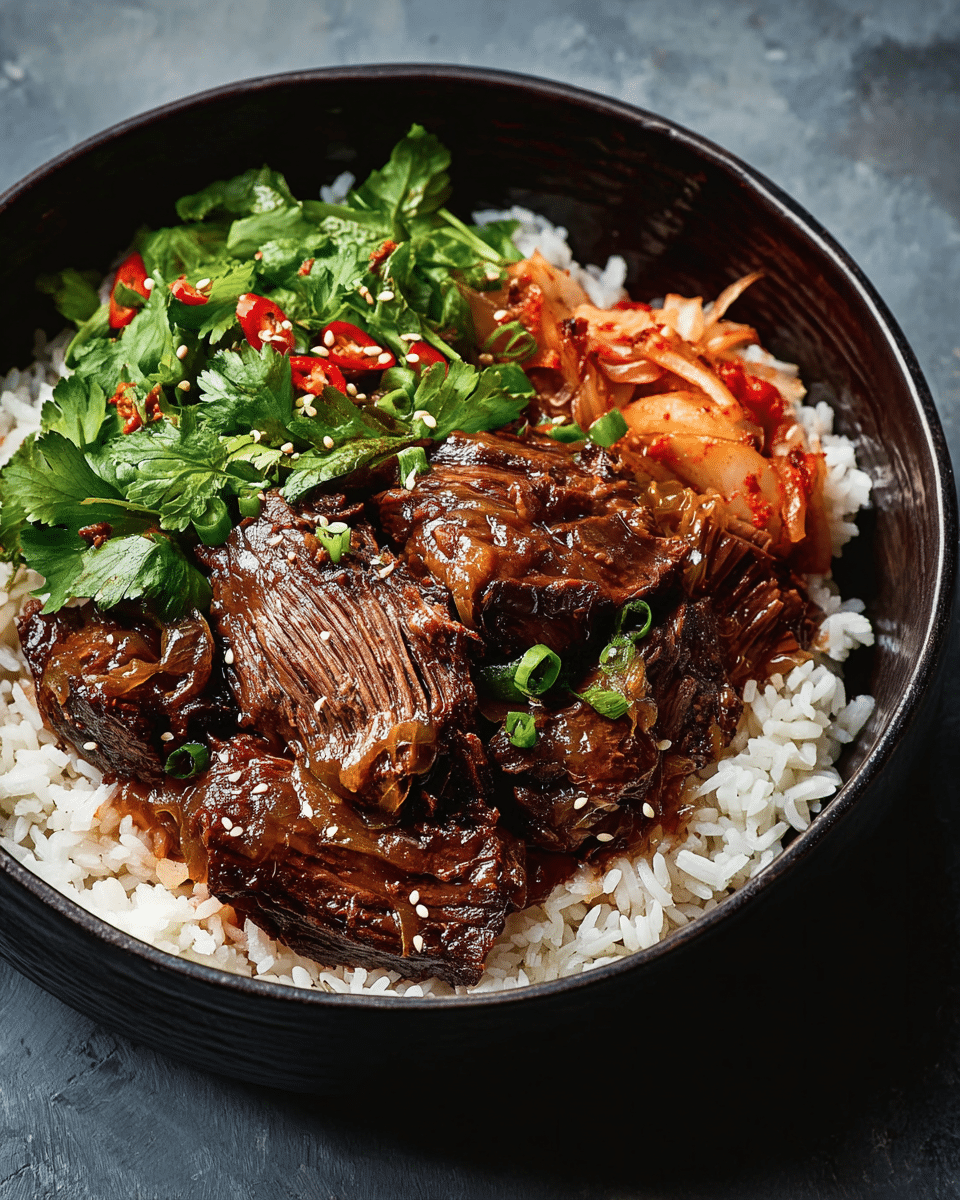This Korean-Style Pot Roast is a beautiful fusion of classic comfort food and bold East Asian flavors. The beef is slow-cooked until incredibly tender, allowing it to soak up a deeply savory-sweet sauce infused with soy, garlic, ginger, and the unmistakable heat of gochujang. It’s the kind of dish that makes your home smell amazing and tastes even better than it looks hearty, balanced, and absolutely satisfying. The presentation is rustic yet elegant garnished with fresh green onions and sesame seeds, served over a bed of fluffy white rice or nestled among noodles. Whether you’re hosting a cozy dinner or meal prepping for the week, this dish offers restaurant-quality flavor with the convenience of a slow cooker. It’s a delicious way to bring Korean flair to your dinner table without spending hours in the kitchen.
Full Recipe:
Ingredients:
-
3–4 lbs beef chuck roast
-
1 tablespoon sesame oil
-
1 yellow onion, sliced
-
5 cloves garlic, minced
-
1 tablespoon fresh ginger, grated
-
3/4 cup soy sauce
-
1/2 cup brown sugar
-
1/4 cup rice vinegar
-
1 tablespoon gochujang (Korean chili paste)
-
1 tablespoon fish sauce
-
1 cup beef broth
-
1 tablespoon cornstarch + 1 tablespoon water (slurry)
-
4 green onions, sliced for garnish
-
Sesame seeds, for garnish
Directions:
-
Pat the beef roast dry and season lightly with salt.
-
Heat sesame oil in a large skillet over medium-high heat. Sear the beef on all sides until deeply browned. Transfer to a slow cooker.
-
In the same skillet, sauté onions until soft. Add garlic and ginger and cook for 1 minute.
-
Stir in soy sauce, brown sugar, rice vinegar, gochujang, fish sauce, and beef broth. Bring to a simmer.
-
Pour the sauce over the beef in the slow cooker. Cover and cook on low for 8 hours or high for 4-5 hours, until the meat is fork-tender.
-
Remove the beef and shred it with two forks.
-
In a small saucepan, bring 1 cup of the cooking liquid to a simmer and stir in the cornstarch slurry. Cook until thickened.
-
Pour the sauce over the shredded beef. Garnish with green onions and sesame seeds. Serve with steamed rice or noodles.
Prep Time: 15 minutes | Cooking Time: 8 hours | Total Time: 8 hours 15 minutes
Kcal: 455 kcal | Servings: 6 servings
Korean-Style Pot Roast: A Fusion of Comfort and Bold Flavors
Korean-Style Pot Roast is a dish that beautifully bridges the gap between familiar Western comfort food and the assertive, umami-rich palate of Korean cuisine. It’s a slow-cooked marvel, where a humble beef chuck roast is transformed into a tender, flavorful centerpiece with the help of soy sauce, gochujang (Korean chili paste), aromatics, and slow, patient cooking. This recipe resonates with food lovers who appreciate deep flavors, comforting textures, and a bit of culinary exploration.
While the idea of pot roast evokes memories of Sunday dinners and cozy gatherings in many households, infusing it with Korean ingredients brings an exciting twist that elevates the experience entirely. The result is a meal that is as soothing and hearty as a traditional roast, but with layers of flavor that are spicy, sweet, and deeply savory a true celebration of global culinary fusion.
The Origins of Korean Flavor Influence
Korean cuisine is known for its complexity, balance, and the artful combination of spicy, salty, sweet, and umami elements. Key ingredients like gochujang, fermented soy sauces, garlic, ginger, and sesame oil are staples in Korean kitchens and have found their way into fusion recipes around the world. This pot roast borrows from classic Korean bulgogi and galbi marinades, infusing the beef with a rich, almost barbecue-like flavor that slowly builds with every bite.
The method of braising or slow-cooking meat is also familiar in Korean cooking. Dishes such as galbijjim (braised short ribs) are beloved examples of how Koreans tenderize tougher cuts of meat over low heat for hours to extract maximum flavor and texture. This recipe takes that same principle and applies it to a Western-style roast, making it a dish that honors both traditions.
Why This Recipe Works
One of the standout features of Korean-Style Pot Roast is its balance. The savory soy base mingles beautifully with the sweet brown sugar and rice vinegar, while gochujang brings a subtle heat that lingers without overwhelming the palate. The beef absorbs all these flavors during its long cook time, resulting in a fork-tender texture that melts in your mouth.
The sauce doesn’t just complement the beef it becomes an essential part of the dish. Reduced and thickened slightly before serving, the sauce clings to every shred of meat, enhancing both flavor and mouthfeel. Served over steamed white rice or egg noodles, the dish becomes a complete, nourishing meal that’s as satisfying as it is flavorful.
Moreover, the recipe is versatile. You can prepare it in a slow cooker, Instant Pot, or even on the stovetop in a Dutch oven. It’s excellent for batch cooking, freezes well, and the leftovers taste even better the next day.
Ideal for Weeknights and Entertaining Alike
While traditional pot roast is typically reserved for special weekend meals due to the long cooking time, this Korean-style version can easily be adapted to a busy weekday schedule thanks to the convenience of slow cookers or programmable multi-cookers. You can sear the meat and prep the sauce in the morning, let it cook low and slow throughout the day, and return home to an incredibly aromatic and ready-to-serve meal.
For those hosting dinner parties or family gatherings, Korean-Style Pot Roast also offers a standout option. It’s familiar enough to appeal to traditional tastes but unique enough to pique curiosity. It pairs beautifully with simple sides such as steamed rice, sautéed bok choy, roasted vegetables, or even a crunchy cucumber salad to offset the rich flavors.
Health and Nutritional Notes
Despite its indulgent, hearty nature, Korean-Style Pot Roast can fit into a variety of dietary needs with slight modifications. For a lower sodium version, you can opt for low-sodium soy sauce. To reduce sugar, you might substitute brown sugar with coconut sugar or even a sugar alternative. Those on a gluten-free diet can easily swap in tamari or coconut aminos.
Beef chuck is a relatively fatty cut of meat, which contributes to its tender texture and full flavor when cooked properly. However, for those seeking a leaner version, you might try this with a trimmed beef round or brisket, though cooking times may need adjustment to retain tenderness.
Pairing this protein-rich dish with fiber-rich sides such as brown rice, leafy greens, or roasted root vegetables can help create a balanced meal that’s both satisfying and nourishing.
Flavor Pairings and Serving Ideas
Korean-Style Pot Roast is incredibly versatile when it comes to plating and accompaniments. Here are a few ideas to elevate your presentation and dining experience:
-
Traditional Pairing: Serve the roast over steamed jasmine or short-grain rice, allowing the sauce to soak into the grains.
-
Fusion Style: Try serving it in toasted sandwich buns with kimchi slaw for a Korean-inspired pulled beef sandwich.
-
Healthy Bowls: Create a beef rice bowl with roasted vegetables, pickled radish, fresh cucumber, and a drizzle of sesame oil.
-
Noodle Night: Serve over wide egg noodles or udon for a more Western-style comfort food twist.
-
Taco Tuesday Upgrade: Use the shredded beef in warm tortillas with Asian slaw and sriracha mayo for fusion tacos.
Don’t forget garnishes sliced scallions, toasted sesame seeds, chopped cilantro, or even a squeeze of lime can add brightness and contrast to the dish.
Cultural Appreciation Through Cooking
Cooking fusion dishes like this pot roast is more than just mixing flavors it’s about cultural appreciation. As global travel and media continue to make world cuisines more accessible, home cooks are increasingly open to experimenting with unfamiliar ingredients. This recipe is a testament to how cooking can be a form of exploration, storytelling, and connection.
By bringing together techniques and flavors from Korean and Western kitchens, we’re not just creating new recipes we’re opening doors to deeper appreciation for food traditions across the world.
Conclusion:
Korean-Style Pot Roast is more than a comforting meal it’s an adventure in flavor and a perfect example of how traditional cooking methods can evolve and adapt across cultures. Whether you’re new to Korean flavors or a longtime fan of gochujang and soy-based sauces, this dish offers something to love.
It’s hearty enough for winter dinners, yet balanced and vibrant enough to enjoy year-round. With its simple preparation, complex flavors, and stunning versatility, this pot roast may soon become a staple in your weekly meal rotation.






